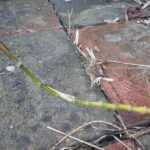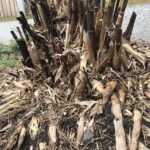Call us free on 0808 168 9540
Call us free on 0808 168 9540

At Phlorum we are bamboo removal specialists, with many years’ experience of invasive bamboo removal. Bamboo can cause expensive problems. If it affects your property then you need to know the risks and how to manage them effectively.
Bamboo comprises a huge variety of species that produce woody canes with characteristic rings, called nodes, that are evenly spaced along the stems (culms). Most species and varieties are tall, growing up to head height for some shorter species and up to the roof level of a standard house for some of the larger species.
In their native range, such as Japan and China, the canes of some long-lived species in the wild can grow much taller than this (giant bamboo has been recorded reaching 50m in height). Similarly, the thickness of the ruler-straight canes can be as thin as a centimetre to wider than can be gripped by a hand.
The rapid rate of growth, architectural stature and pleasing shape of the characteristic canes makes bamboo a very popular garden plant. It also has many practical uses such as to make roof tiles and even scaffolding.








The rapid rate of growth and the toughness of its canes and new shoots, coupled with the fact that some species of bamboo can spread very far, and at alarming rates, can make bamboo more damaging than Japanese knotweed.
As such there is an increasing number of nuisance claims issued against land owners who have allowed bamboo planted on their land to spread onto adjacent properties, where damage has been caused.
Such damage can include the damaging of built structures (e.g. walls, outhouses and sheds), the lifting of paving slabs, the swamping of other garden plants and the ruining of lawns and astroturf.
Many problems occur particularly with running bamboos (i.e. species and varieties that have running rhizomes that can grow outwards very far from the original location where they were planted). This is usually a problem when such bamboos are not planted in pots or other types of containers that prevent the plants’ rhizomes from spreading outwards.




There are two main types of bamboos: running bamboos; and clumping bamboos.
Running bamboos are those with rhizomes that readily run through the ground, causing culms to spread.
Clumping bamboos are generally more well-behaved, staying roughly in the same spot, forming clumps.
However, due to the huge variety of bamboo plants that have been bred for garden use, many running bamboos can clump and many clumping bamboos can run. Therefore, accurate identification of a species or variety is often not particularly useful.
What’s more important is to determine whether a bamboo is causing, or is likely to cause, a problem. This is often obvious and it is what triggers most calls to us to solve the problem when a bamboo has grown out of control.
However, we are also called out to investigate bamboo to provide proactive advice on its management or treatment. This is often required by those looking to buy or sell a property that might be adversely affected by bamboo.




The most damaging bamboos produce pointed culms that poke from the ground like small spears.
Due to them arising from an established rhizome system underground, the emerging culms are powered by the starchy rhizomes such that they can grow at an alarming rate – some species easily reaching 10m in a single season.
This incredible rate of growth, combined with the spear-like shape of the culms, allows some bamboos to grow through many types of built structures and surfaces, ripping and pushing them apart.
By simply being invasive (i.e. growing quickly and covering wide areas) bamboos can quickly outcompete other plants, making regular garden maintenance a necessity to stay on top of the plant to prevent it spreading.
If you realise that your, or your neighbour’s, bamboo is out of control, you will probably want to get rid of it.
There are two ways to achieve bamboo removal: with herbicides; or by digging it out and disposing of the waste.
Professionally applied herbicides, applied at the right time of year and in the correct dose, can kill most bamboos quite effectively. However, the larger the stand, the longer it will likely take, with repeat applications for several years often being necessary.
For particularly tall bamboos with foliage that’s hard to reach, it can help if you cut the canes down in the winter and wait for new leaves to appear in the spring and summer, at a level that’s easier to reach to apply the herbicide to. ‘Stump treatment’ herbicides, applied to the cut stumps, can also be effective. In this case, the canes can be cut lower down, close to the ground. This has the benefit over foliar sprays in that the visual impact is removed immediately by cutting down the stand. For particularly dense stands of bamboo, stump treatments can take several applications to be effective.
If the problem needs sorting out as quickly and as completely as possible, then the only way to go is to dig out and remove all of the bamboo rhizomes from the ground. This should be done professionally. It is the most common type of bamboo work that Phlorum undertakes. With our vast experience in dealing with similar property issues caused by Japanese knotweed, Phlorum is ideally placed to quickly, effortlessly and cost-effectively deal with any bamboo problems that affect property.
If you intend to keep your bamboo, we can help with advice and contractor services to make sure it is kept in check and doesn’t become a problem in the future. Pruning the rhizomes and removing sections of bamboo are fairly straightforward. What’s desired to be retained can then be kept using a variety of root barriers or containers. Due to the toughness and spear-like culms that emerge from rhizome buds in the ground, the root barriers used to contain bamboo are much tougher than the usual type of weed barriers used for other weeds (they are even tougher than those used to control Japanese knotweed!).
The costs to completely remove bamboo from a property by digging up the rhizomes and appropriately disposing of all the wastes will obviously depend on the size of the infestation and how many properties it affects.
Price ranges for excavation are wider than for herbicide treatment as there are many variables that can affect the volume of wastes that arise.
Herbicide treatment costs will be cheaper if they are for a single herbicide application. However, although an initial application can have a significant impact, it is usual for repeat applications to be required for several subsequent years, which some customers might consider more manageable and cost-effective to take on themselves (unlike the situation for knotweed, there is no current industry standard for bamboo treatment, and no requirement for professionals to issue insurance backed guarantees – this could all change in future though).
Rough ranges of bamboo removal costs are provided in the table below – please contact us for costs and advice on your specific bamboo problem.
We may charge for an initial survey, to assess the area and excavation or herbicide treatment requirements.
| Size of infestation | Small (<2m2> | Medium (2m2-10m2) | Large (10m2-50m2) | Very large (50m2-100m2) |
|---|---|---|---|---|
| Herbicide treatment | £250-£1,000 | £1,000-£1,500 | £1,500-£2,000 | £2,000-£3,500 |
| Full evacuation | £3,000 | £3,000-£6,000 | £6,,000-£10,000 | £10,000-£20,000 |